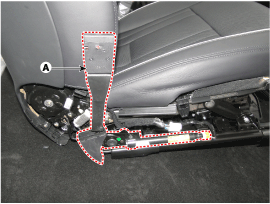Hyundai Genesis: Seat Belt Pretensioner / Emergency Fastening Device (EFD) Repair procedures
Hyundai Genesis (DH) 2013-2016 Service Manual / Restraint / Seat Belt Pretensioner / Emergency Fastening Device (EFD) Repair procedures
| Removal |
| 1. |
Disconnect the battery negative cable, and wait for at least three minutes before beginning work. |
| 2. |
Remove the front seat assembly.
(Refer to Body - "Front Seat Assembly") |
| 3. |
Remove the front seat outer shield cover.
(Refer to Body - "Front Seat Outer Shield Cover") |
| 4. |
Disconnect the EFD system connector. |
| 5. |
Unscrew the mounting bolt from the front seat assembly, and then remove the EFD system (A).
|
| Installation |
| 1. |
Disconnect the negative (-) cable from battery and wait for at least three minutes. |
| 2. |
Install the EFD system with the mounting bolt.
|
| 3. |
Connect the EFD system connector. |
| 4. |
Install the front seat shield outer cover.
(Refer to Body - "Front Seat Outer Shield Cover") |
| 5. |
Install the front seat assembly.
(Refer to Body - "Front Seat Assembly")
|
| 6. |
Reconnect the battery negative cable. |
| 7. |
After installing the EFD system, confirm proper system operation:
Turn the ignition switch ON; the SRS indicator light should turn on for about six seconds and then go off. |
 Pre-activeSeat Belt (PSB) Components and Components Location
Pre-activeSeat Belt (PSB) Components and Components Location
Components
1. Pre-active Seat Belt (PSB)2. Center Pillar
1. Pre-active Seat Belt Unit (PSB)
...
Other information:
Hyundai Genesis (DH) 2013-2016 Service Manual: Repair procedures
Component Replacement after Deployment Before doing any SRS repairs, use the GDS to check for DTCs. Refer to the Diagnostic Trouble Code list for repairing of the related DTCs. When the front airbag(s) deployed after a collision, replace the following items. - SR ...
Hyundai Genesis (DH) 2013-2016 Service Manual: Output Speed Sensor Repair procedures
Inspection 1. Check signal waveform of output speed sensor using the GDS. Specification: Refer to "Signal Wave Form" section. ...
© 2013-2025 www.hgenesisdh.com



